Tag Archive: intervention
June 2, 2012
by Carole Zangari -
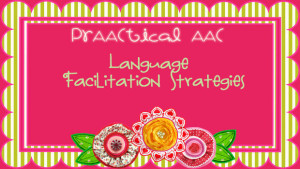
Well, it’s Week 4 of the new semester, and in our AAC classes, we’ve been talking a lot about how language is represented and organized in communication boards/books, SGDs, and AAC apps. We’ve talked about the pros and cons of representing language in various ways and discussed the options for setting up displays so that people can easily access the words they need. At this point, we know how to choose appropriate symbols, select appropriate vocabulary, and arrange it in an appropriate format. In short, we know how to put language ‘in.’ Now comes the hard part: Getting it out. How do we get people to actually use the language that’s been so carefully stored in the no-tech, low-tech, and high-tech AAC tools? Our June Strategy of the Month is about techniques for language facilitation. If you’re an SLP well-versed in language therapy with speaking children, these posts will cover... [Read More...]
Filed under: Strategy of the Month
Tagged With: aided language input, expansion, extension, intervention, language
May 31, 2012
by Carole Zangari -
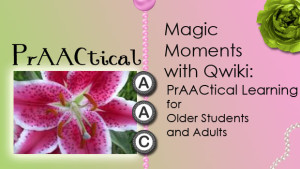
Magic Moments is an occasional series that discusses prAACtical ways of using favorite toys, games, apps, and selected websites for language and literacy learning. Our last Magic Moments post featured Toca Store, an app for children, so this time we raised our sights to address an older demographic. There are fewer age-appropriate, interesting materials designed especially for the AAC and learning needs of this age group so we are always on the hunt for creative ideas. Since we’re sharing digital curation tools as part of our May Strategy of the Month, we thought this would be a perfect opportunity to talk about ways to use Qwiki with clients who use AAC. and websites for communication learning. – Qwiki is an aggregation tool that combines video and web interactivity into a brief multimedia presentation. In their reference site, Qwiki allows you to enter a search term and get an interesting overview of that topic with images,... [Read More...]
Filed under: PrAACtical Thinking
Tagged With: digital curation, implementation ideas, intervention, Magic Moments
May 21, 2012
by Carole Zangari -
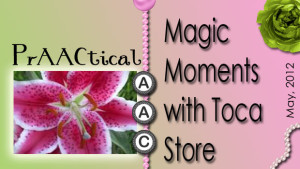
It’s no coincidence that some of our favorite apps to use with AAC kids don’t rely on good receptive language in order to be successful and have fun. Count us among the fans of Toca Boca for their creative play-based apps with great graphics and lots of repetition with variety. In this post, we share some Magic Moments for using Toca Store as a communication-building experience.– 1. Core Word Practice: Lots of opportunities for practice with familiar nouns (e.g., banana, doll), common verbs (e.g., get, see, want) and modifiers (colors, some, little). 2. Negation: This is another fun app to use when teaching a child to use language appropriate for negation, protests, and rejection. We like teaching that under low stress conditions like this at first to build their skills. Once they get the hang of it, then we help them use it under more natural conditions. That way we can... [Read More...]
Filed under: PrAACtical Thinking
Tagged With: Apps, intervention, Magic Moments
May 15, 2012
by Carole Zangari -
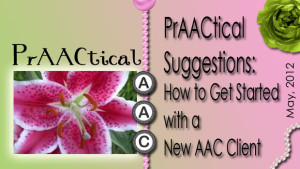
– This is the first week of a new semester for us, and that means we get the pleasure of introducing a new crop of student SLPs to clients with AAC needs. We’ve been busy looking at lesson plans, discussing goals and objectives, listening to ideas for therapy activities, and helping to develop plans for data collection. With those recent conversations buzzing in our ears, here are some thoughts about getting AAC therapy sessions off to a good start. – 1. Connect with the client and family before the first session. Take some time to plan out questions that will help you get to know their expectations, family culture, and daily routine. 2. Know the history. Go beyond the diagnosis and device. Take time to research what’s been done before, how that worked out, and, if you can, how that was perceived. Knowing where the client has been on his/her... [Read More...]
Filed under: PrAACtical Thinking
Tagged With: intervention, SLP
May 6, 2012
by Carole Zangari -
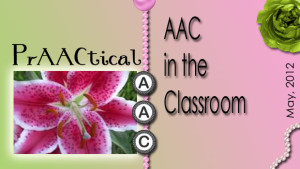
AAC Extreme Makeover: Classroom Edition is a recorded presentation based on a full workshop for educators and clinicians. In this 3-part series hosted by SET BC, Gail Van Tatenhove provides an overview of 6 fundamental concepts for implementing AAC in special and general education classrooms. Each segment is less than 30 minutes and has narrated PowerPoint slides.
Filed under: Video of the Week
Tagged With: intervention, schools
May 1, 2012
by Carole Zangari -
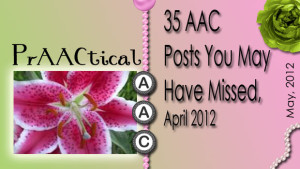
— – – Strategy of the Month From Disney Princesses to Houseplants: More on Building Communication Opportunities 5 Apps for Tempting Commenting and Other Language Functions Go Ape! 10 Commenting Communication Temptations PrAACtical Play: Creating Communication Opportunities with Favorite Toys How to Make Communication Temptations Really Work Mining Preschool Routines for PrAACtical AAC Opportunities. Meaningful Communication Opportunities – The Fives 5 ‘Go-To’ Sites for AAC and Visual Support Downloads 5 Apps for Tempting Commenting and Other Language Functions 5 AAC-Related Facebook Pages/Groups We Love 5 Tools and Tips for Making Transitions Easier 5+ Sites for Free AAC-Friendly Literacy Resources 5 eGames for Switch Users 5 AAC/AT YouTube Channels We Love – PrAACtical Thinking 49 Free or Lite Versions of AAC Apps A Myth About Visual Schedules Lives On PrAACtical Resources: Making Decisions about Reading Accessibility Options PrAACtical Resources: Toolkit for ASD PrAACtical Questions: How Do I Find Good AAC Service... [Read More...]
Filed under: PrAACtical Thinking
Tagged With: intervention, Opportunities, resources, visual schedule
April 28, 2012
by Carole Zangari -
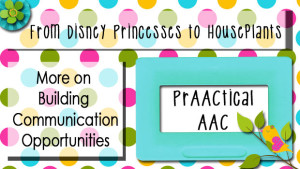
Mining everyday routines at home, in school, and in therapy sessions for communication teaching opportunities is a great way to get started in boosting the effectiveness of AAC intervention. We are inspired when we see clinicians enhance their clients’ learning by making subtle, but important changes. – I was thrilled to hear one SLP talk about how she ‘found’ more AAC practice for a teenager by offering more choices in her therapy games. Once he chose a TV character for the activity, LeVon then had to specify what action he/she would do (e.g., dance, drive, clap) and a location in which to do it (e.g., home, school, beach). Agent, action, location. Hmm…sounds like a good start for sentence-building, with a little aided language input and expansion thrown in for good measure. “Quinn drive beach.” “Yes. Quinn drove to the beach in his truck.” And it gives us great pleasure to... [Read More...]
Filed under: Strategy of the Month
Tagged With: intervention, Opportunities
April 21, 2012
by Carole Zangari -
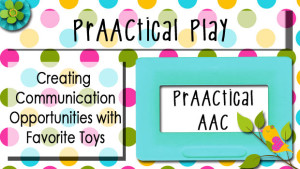
– Guest post by Stefanie Finocchio, M.S., CCC-CF As we’ve said before, we feel incredibly fortunate to have made our careers educating the next generation of SLPs. Sharing what we’e learned about AAC, AT, autism, literacy, and language intervention with graduate student clinicians is a challenge we both love. In this post, we share the wonderful ideas of a recent graduate, Stefanie Finocchio. Although she has only been out of grad school for a few months, Stefanie has some very prAACtical ideas about how to create communication opportunities for young children who are learning to use AAC. – One of my favorite “go-to” activities/games that I use frequently with my students diagnosed with autism is the Playskool Busy Gears game by Hasbro. It comes with 11 plastic gears of all different sizes and colors. Once a gear is placed on the board, you hit a button on the bottom and... [Read More...]
Filed under: Strategy of the Month
Tagged With: intervention, Magic Moments, Opportunities
April 18, 2012
by Carole Zangari -
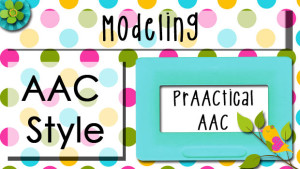
This is a strategy that is too powerful to ignore. Here’s why Aided Language Input is at the top of our list of skills that all clinicians should master. – 1. Helps children and adults learn their AAC faster: There is good research demonstrating how valuable this kind of modeling is for our AAC clients. See studies by Drs. Kathryn Drager, Cathy Binger and Janice Light, Jennifer Kent-Walsh, Shakila Dada and Erna Alant for starters.– 2. Helps the SLP get competent with the client’s AAC system: This is hands-down the quickest way for us to get familiar with our client’s AAC device. – 3. It’s common sense: Think about it: How many times does a typical 1-year old hear the word ‘more’ before she says it?? Don’t AAC kids need that much exposure to ‘their’ language systems?? – 4. Expands our sphere of influence: Other communication partners will imitate us. If WE use it, then parents and teachers are... [Read More...]
Filed under: PrAACtical Thinking
Tagged With: intervention
April 14, 2012
by Carole Zangari -
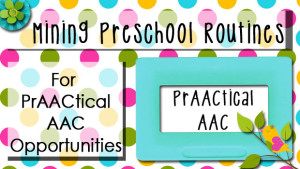
Meet Jenna, a spirited little girl with developmental delays who is learning to communicate using multiple modalities. Follow her along this morning as she goes to her preschool and gets dozens of opportunities to practice the AAC skills she is learning. 101 opportunities to practice target skills before lunch? It’s a piece of cake with this well-oiled preschool team! Jenna’s communicative functions are noted in CAPS and her communication modalities are in italics. – Let’s watch and see how Jenna is getting all that practice in as she goes about her day. – 7:55 1. Enter the building, pause at a trained adult communication partner (receptionist) for Jenna to GREET with a vocalization and wave 2. ANSWER a social question (“How are you?”) with gesture (thumbs up) 3. Say GOODBYE with a wave 4. Once in the classroom, repeat GREETINGS with teacher, aide, and a friend. 5. ASK for HELP putting... [Read More...]
Filed under: Strategy of the Month
Tagged With: intervention









